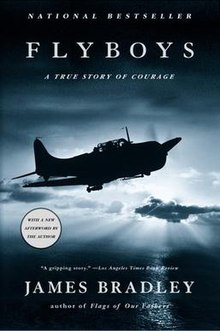Flyboys: A True Story of Courage
 Hardcover edition | |
| Author | James Bradley |
|---|---|
| Subject | World War II |
| Publisher | Little, Brown |
Publication date | 2003 |
| ISBN | 978-0-316-10584-2 |
| OCLC | 52071383 |
| 940.54/05/09528 21 | |
| LC Class | D804.J3 B73 2003 |
Flyboys: A True Story of Courage is a nonfiction book by writer James Bradley, and a national bestseller in the U.S. This book details a World War II incident of the execution and cannibalism of five of eight American P.O.W.s on the Pacific island of Chichi-jima, one of the Ogasawara Islands (Bonin Islands).
Overview
As in Mr. Bradley's book Flags of Our Fathers, he sympathetically and poignantly describes the small-town teenage backgrounds and aspirations of several of the American flyboys, and how they came to enlist in the Navy. He also interviewed several aged, repentant Japanese veterans who were willing to tell how they were brainwashed and forced into barbarous acts because of the Japanese military culture of obeying without question.[1]
Additionally, it documents Japan's rise to power from 1849 to 1941, analyzes the rise of the airplane in warfare, and the military establishment's failure to heed the 1920s warnings of General Billy Mitchell that the American military build up its air power. The book analyzes various cruelties, hypocrisies, and war crimes of the Japanese and its government. It compares the atrocities Japanese troops committed on a large scale against Chinese civilians, with similar atrocities committed by American forces against Filipinos during and after the Spanish–American War, and earlier by American troops against native American Indians. Both the American and Japanese populaces were arrogantly indoctrinated that their national cultures were uniquely superior, which gave them the right to impose those cultures through imperialism on other weaker countries, whose people were viewed as subhuman.[1]
As U.S. Marines in 1945 invaded Iwo Jima some 150 miles away, U.S. warplanes bombed the small communications outpost on Chichi Jima. While Iwo Jima had Japanese forces numbering 22,000, Chichi Jima's forces numbered 25,000. Additionally, Iwo Jima has flat areas suitable for a naval invasion, while Chichi Jima's geography included hilly terrains and unsuitable coasts. According to one Marine (whom Bradley does not identify), "Iwo was hell. Chichi would have been impossible." Assumedly, it is because of this that U.S. pilots, known as "Flyboys", were needed to neutralize Chichi's defenses.[1]
Ten crewmen survived after being shot down in the raids. One was picked up by the American submarine USS Finback. He was Lieutenant George H. W. Bush, who later became the forty-first President of the United States. The others were captured by the Japanese and were executed and partially eaten as POWs, a fact that remained hidden until much later. The names of Flyboys were Jimmy Dye from Mount Ephraim, New Jersey, Floyd Hall from Sedalia, Missouri, Marve Mershon from Los Angeles, California, Warren Earl Vaughn from Childress, Texas, Dick Woellhof from Clay Center, Kansas, Grady York from Jacksonville, Florida, Glenn Frazier from Athol, Kansas, and the Unidentified Airman, who was revealed to Bradley as Warren Hindenlang of Foxboro, Massachusetts after the publication of the hardcover edition. William L. Connell from Seattle, Washington survived the POW camps.[2]
Senior Japanese Army Officers hosted a Sake party for their Navy counterparts where the livers of American POWs were roasted and served as an appetizer. The Japanese Navy officers subsequently reciprocated by hosting a party where they butchered and served their own American POWs.[1]
The book also documents Japanese cannibalization of not only the livers of freshly killed prisoners, but also the cannibalization-for-sustenance of living prisoners over the course of several days, amputating limbs only as needed to keep the meat fresh in the harsh jungle environment. It also cites cannibalism of Allied soldiers killed in action and of Japanese dead, wounded and by lot drawings.[3]
These atrocities on Chichi-jima, were discovered in late 1945 and was investigated as part of the war crimes trials. In 1946, 30 Japanese soldiers were court-martialed on Guam and four officers (Maj. Matoba, Gen. Tachibana, Adm. Mori and Capt. Yoshii) were found guilty and hanged. All of the enlisted men were released within eight years.[4]
References
- ^ a b c d Bradley, James (2003). Flyboys: A True Story of Courage (hardcover) (1st ed.). Little, Brown and Company (Time Warner Book Group). ISBN 0-316-10584-8.
{{cite book}}:|access-date=requires|url=(help) Note: Google review - ^ Bradley, James (2006) [2003]. Flyboys: A True Story of Courage (1st ed.). Little, Brown and Company (Time Warner Book Group). pp. 484–486. ISBN 0-316-10728-X.
{{cite book}}:|access-date=requires|url=(help);|format=requires|url=(help) - ^ Bradley, James (2004) [2003]. Flyboys: A True Story of Courage (softcover) (first ed.). Boston, MA: Back Bay Books. pp. 229–230, 311, 404. ISBN 0-316-15943-3. Retrieved 2007-12-26.
- ^ Welch, JM (April 2002). "Without a Hangman, Without a Rope: Navy War Crimes Trials After World War II" (PDF). International Journal of Naval History. 1 (1). Retrieved 2007-12-03.
{{cite journal}}:|chapter=ignored (help)
